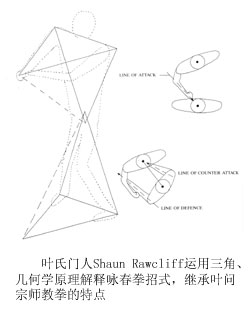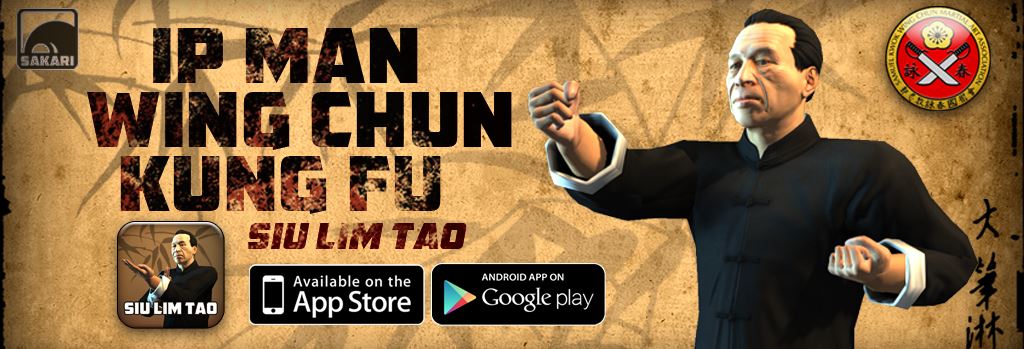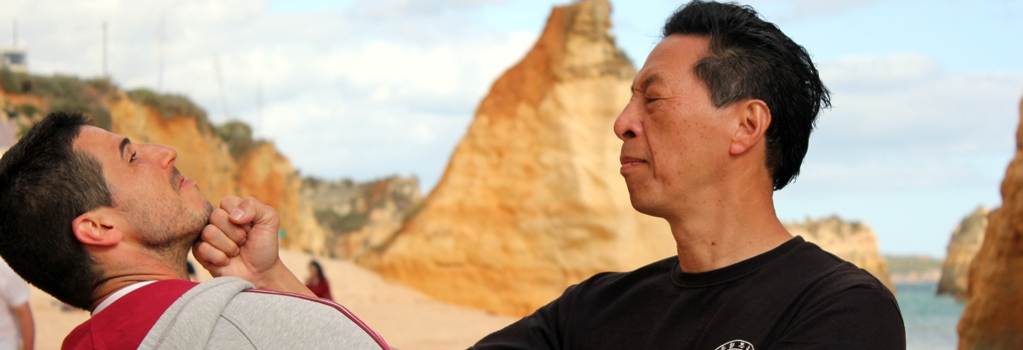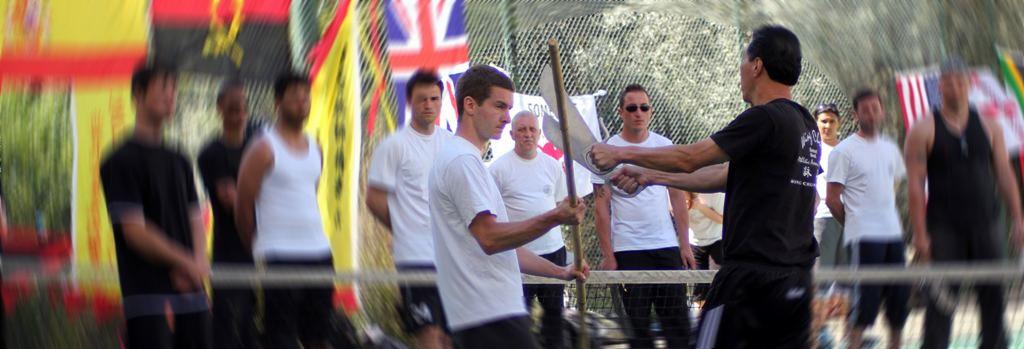Principles vs Techniques
Article by Dan Knight added on 3 Aug 2012. Last updated on 12 Mar 2014.
The Why vs The How
The purpose of Wing Chun Kung Fu is to lead you to be free and relaxed. This can never be achieved if you are tied physically and emotionally to techniques. You must free yourself from dependence on mechanical expression and trust your body, your Kung Fu to protect yourself
- Moy Yat
Wing Chun is an art in which principles are more important than specific techniques. This does not mean that Wing Chun does not have techniques. It means that at the root of all techniques are underlying principles and thus all techniques can be adjusted in accordance to those principles. By studying an art which is based on principles instead of techniques, the practitioner is able to take his or her art and make it their own. If the principles are understood, the practitioner can take that art into any situation or scenario and learn to apply it. The student must learn to understand the principles as they apply to their individual body type, mindset and physical attributes, not just learn choreographed forms or memorized techniques and drills the same way as everyone else in the class or even the same way that the teacher executes them. Perhaps this is why Ip Man is famous for saying the following.
If you believe everything I say you will never be a good fighter. - Ip Man
 The above quote from Ip Man seems to contrast the idea of a system which is built upon forms (pre-determined sets of techniques that have to be learned). However forms not only give the practitioner sets of techniques they also show principles. For instance how to generate power by turning, simultaneous attack and defense. Therefore before the practitioner can develop their own style they need something to build upon. This is why, all students are taught pretty much the same concepts, theories, and exercises. This is necessary in order to gain a foundation. Some people are happy just following others in their training and this is will provide them with a reasonable amount of skill, but it is not Wing Chun.
The above quote from Ip Man seems to contrast the idea of a system which is built upon forms (pre-determined sets of techniques that have to be learned). However forms not only give the practitioner sets of techniques they also show principles. For instance how to generate power by turning, simultaneous attack and defense. Therefore before the practitioner can develop their own style they need something to build upon. This is why, all students are taught pretty much the same concepts, theories, and exercises. This is necessary in order to gain a foundation. Some people are happy just following others in their training and this is will provide them with a reasonable amount of skill, but it is not Wing Chun.
High level Wing Chun application is not pre-calculated or preconceived, it is not reproducing techniques that one has copied from another; it is true improvisation. High level Wing Chun is about creating in the moment, it is about responding to an opponent's movement in ways that you may have never expressed before in practice. It is about being unpredictable, yet still responding appropriately. A high level Wing Chun practitioner can respond to any situation, even if they have never faced it before because he or she has worked long and hard to make the principles of Wing Chun a part of their natural response to any situation. This level of ability is developed largely through Chi Sau. Chi Sau is a type of training exclusive to Wing Chun. Chi Sau has no decoratively specified code of conduct and does not follow predefined movements or techniques, it has common elements but it is ultimately what the practitioner makes of it. Chi Sau should never be about winning or losing it should be about improving. It is a training method aimed to help the practitioner understand how to apply Wing Chun for themselves and as such there are no right or wrong techniques. Some techniques will not work others will leave the practitioner open and some movements will work against some people but not others. The more you train in Chi Sau against different people the more you realize that the only thing you can rely on is a principle not a technique.
Understand the principles for your training. Wing Chun kuen Kuit
For instance a Biu Sau is a great technique to stop a straight punch. But if you take it solely as a technique it is flawed. A technique does not take into account who is attacking you or even who you are, it is just a movement. Therefore if someone who is considerably shorter than you throws a straight punch and you try to use a Biu Sau, your opponents punch will likely be delivered under you technique, because they are punching up and a Biu Sau works by receiving and deflecting force that is the same height or higher than it is. In this example the Biu Sau as a technique fails. This is because the principles that govern the Biu Sau are not being applied to the right situation. However in the same example if you performed a low Gan Sau technique you would be applying the principle of deflection which would in this situation work. But the low Gan Sau would not stop a straight punch from someone the same height as yourself so the only thing that will always be true for a defending a straight punch effectively, is the principle of deflection not any one technique. High level Wing Chun should choose a course of action or type of movement based on important principles not techniques. Chi Sau helps a practitioner understand these principles.
 Many people ask questions like "Does Wing Chun have ground fighting?", or "Can Wing Chun defend against weapons?" The answer is, "Yes", because it is a principle based art, Wing Chun can handle every kind of fighting situation and utilizes every available weapon." Although most Wing Chun practitioners do not practice a lot of ground fighting, the principles of Wing Chun fighting certainly apply as much to ground fighting as they do to fighting on your feet, or with weapons, or any other form of combat. If you watch any good ground fighter, you will notice that they adhere to all the principles of Wing Chun. They are relaxed, they don't use force against force, they utilize optimum angles of attack, etc. These are all principles of Wing Chun. You will find most good martial arts are based around these principles amongst others. To take your Wing Chun to the ground you have to try it out and get some experience of how you can apply it. For instance what position do you need to be in to strike effectively? How do you use deflection when in a "mount" position etc?
Many people ask questions like "Does Wing Chun have ground fighting?", or "Can Wing Chun defend against weapons?" The answer is, "Yes", because it is a principle based art, Wing Chun can handle every kind of fighting situation and utilizes every available weapon." Although most Wing Chun practitioners do not practice a lot of ground fighting, the principles of Wing Chun fighting certainly apply as much to ground fighting as they do to fighting on your feet, or with weapons, or any other form of combat. If you watch any good ground fighter, you will notice that they adhere to all the principles of Wing Chun. They are relaxed, they don't use force against force, they utilize optimum angles of attack, etc. These are all principles of Wing Chun. You will find most good martial arts are based around these principles amongst others. To take your Wing Chun to the ground you have to try it out and get some experience of how you can apply it. For instance what position do you need to be in to strike effectively? How do you use deflection when in a "mount" position etc?
Upon achieving the highest level of proficiency, application of techniques will vary depending on the opponent. Wing Chun kuen Kuit
Any good fighter will vary his fighting strategy based on his opponent and his environment. The opponent could be large or small, tall or short, male or female, fast or slow. The opponent's strengths and weaknesses vs. your own strength and weaknesses will also come into play. The opponent might be a boxer who is good with his hands, a kicker who is good with his feet, a wrestler who is good at grappling, he or she might be carrying a weapon, etc. Additionally, the environment plays a role; it might be dark, the terrain might be rough, it might be in a confined area with limited space to move, etc. So how does one handle all these different situations? Many people try to study lots of different martial arts in order to cover as many scenarios as possible I.e. jujitsu for ground fighting, Ninjitsu for weapons defense, boxing to develop punching power, Mui Boran/Mui Thai to develop kicking power and Wing Chun for close contact fighting. A certain level of all round ability will be achieved by this, but it is only when reaching the high levels of any given martial arts that most people attain good understanding of the principles that are important to them. Too many people try to flood their memory with every possible technique to cover all possible situations and this leads to a very technique based style of learning which will cause problems if the practitioner finds themselves in a situation they haven't trained, or one they can't remember the right technique based solution for, I.e. what do I do if someone bigger than me attacks me when Im sitting down in the bar? Well they will depend where they are in relation to you and there is no real way to train all possible situations, instead it is better and more time effective to train the principles that will protect you where ever you are.
It seems that individuals jump from one art to the next trying to complete their martial arts training because very few martial arts teachers are teaching complete martial arts methods based on principles which can be applied to any situation and/or students are not pursuing these arts in great depth. Any martial art which has been around for a hundred years or more is bound to be a good, complete martial art system, otherwise it would not have lasted. However, today too many people do not fully understand the art they practice or get bored with it before they reach a depth of understanding. Studying choreographed forms and applications and mimicking these memorized routines to get belt ranks falls far short of studying a complete method and understanding how its principles are applied under varying circumstances.
Therefore the practitioner of the martial art should always be asking themselves and their teacher why they are doing something. It is also very important for the practitioner to test what he or she learns. This is often done in Wing Chun by practicing Chi Sau with lots of different people. Wong Shun Leung said:
Wing Chun in theory is perfect but never can someone achieve such a state of perfection. - Wong Shun Leung
This is because Wing Chun is based on principles that are always true. However principles are really just ideas so in order to apply them you must move in a certain way (perform a technique, even if it is something you have never done before). Inevitably the practitioner cannot always perform in the perfect way, they can only train hard to get as close to perfection as their body will allow them.
Tags for this article:
TheoryMmaSparringFightingTechniques



